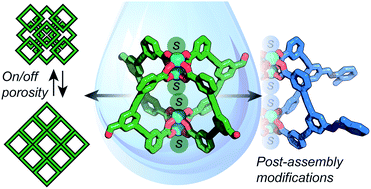On/off porosity switching and post-assembly modifications of Cu4L4 metal–organic polyhedra†
Abstract
Synthetic porous materials composed of metal–organic polyhedra (MOPs) have found application in topical areas such as gas storage, separation and catalysis. Control over their physical properties (e.g. porosity) has typically been achieved through ligand design or judicious choice of metal ions. Here, we demonstrate pore-size control and on/off porosity in Cu4L4 MOPs by exploiting their structural non-rigidity. We report an aldehyde-functionalised MOP (1) that can be isolated in five distinct solvatomorphs, each exhibiting different structural flexibility. When soaked in MeOH, two of these solvatomorphs undergo a rapid transformation to a thermodynamically favoured phase, whilst in acetone they template the crystallisation of an entirely new crystal packing. We support these findings by single and powder X-ray diffraction and rationalise the observed phase transformations by lattice energy calculations. Of the five solvatomorphs, three can be obtained as solvent-exchanged pseudo-polymorphs with distinct porosities in their activated form (SABET = 35–455 m2 g−1). Further control over the crystal packing of MOPs is achieved through covalent post-assembly modifications, which promote the crystallisation of isoreticular 2-D sheet-like structures.

- This article is part of the themed collection: Most popular 2019-2020 inorganic, main group and crystal engineering chemistry articles


 Please wait while we load your content...
Please wait while we load your content...